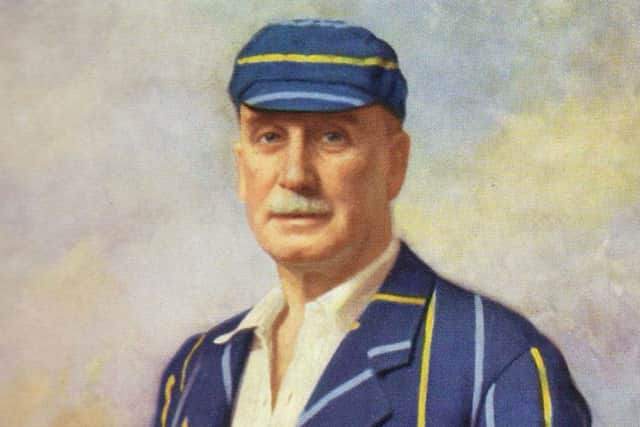Bygones: Recalling how Yorkshire bowler sobered up to shock the Aussies


In an era where no total or target is safe from swashbuckling bats, powered by the prevalence of one-day cricket, the history books are constantly being rewritten.
Last week, one of the oldest records in the book went for a burton in the Test match between New Zealand and Bangladesh in Wellington.
Advertisement
Hide AdAdvertisement
Hide AdIt was a record of the decidedly unwanted sort, Bangladesh taking Australia’s mantle – held for over 122 years – of achieving the highest Test total in a losing cause. Bangladesh could have been forgiven for feeling pretty good about life after scoring 595-8 in their first innings at the Basin Reserve, their second-highest total in Tests.


Shakib Al Hasan scored 217 – the highest ever innings for Bangladesh – and captain Mushfiqur Rahim hit 159, the pair adding 359 for the fifth wicket, a record stand for Bangladesh too.
One would have thought that the visitors would have been pretty safe with that score on the board after Kane Williamson, the New Zealand captain and former Yorkshire batsman, sent them into bat.
But after the hosts replied with 539, Bangladesh were bowled out for 160 – first-innings centurion Mushfiqur forced to retire not out after being struck on the helmet by a Tim Southee delivery – and Williamson had the final word with an unbeaten 104 as the hosts chased 217 inside 40 overs.
Advertisement
Hide AdAdvertisement
Hide AdAs the Kiwis celebrated and Bangladesh headed for the nearest darkened room, those of us with nothing better to do retreated into the archives to research the record that Bangladesh had broken.


After much clambering around through cobwebs and side-stepping spiders, such investigation revealed that the match in question was the opening Test of the Ashes series at Sydney in December 1894.
After winning the toss, Australia amassed 586 – then the highest score in Tests.
But after replying with 325, England made 437 following-on and then dismissed Australia for 166, Yorkshire left-arm spinner Bobby Peel taking 6-67 as the visitors claimed a thrilling 10-run win.
Advertisement
Hide AdAdvertisement
Hide AdIt was the first time that a team had won a Test after being made to follow-on, and there have been only two instances subsequently.


In 1981, England famously beat Australia at Headingley on the back of superb performances from Ian Botham and Bob Willis.
And, in 2001, India famously beat Australia in Kolkata after VVS Laxman’s epic double century.
Considering that last week’s match between New Zealand and Bangladesh was the 2,246th Test, the rarity of such occurrences speaks for itself.
Back to 1894…
Advertisement
Hide AdAdvertisement
Hide Ad

“This was probably the most sensational match ever played either in Australia or in England,” opined Wisden, an institution not given to hyperbole.
“In the face of a score of 586 the Englishmen had a dismal prospect, but they set to work with the utmost resolution.”
That total of 586 represented a recovery after Australia had slipped to 21-3 on the first day, fast bowler Tom Richardson with all three wickets.
Richardson, of Surrey, was one of the greatest bowlers of his era, his stamina such that it was said that he used to walk to the Oval from his home each day and back again – a distance of some 14 miles – with his kit bag on his shoulder.
Advertisement
Hide AdAdvertisement
Hide AdAfter Richardson’s early salvo, George Giffen, the first great Australian all-rounder, added 171 with Frank Iredale, who struck 81, and then 139 with Syd Gregory before being dismissed for 161.
Gregory, a diminutive, wristy right-hander, who had only once reached double figures in his six previous Tests, went on to the top score of 201, the first double hundred in Tests in Australia.
Gregory was shepherded to the milestone by captain Jack Blackham, aka “The Prince of Wicketkeepers”, who chipped in with 74 in a ninth-wicket stand of 154, still an Australian Test record.
Peel returned 2-140 from 53 overs and, when England replied, he made four from the No 6 position and debutant Jack Brown – the only other Yorkshire player in the side – 22 from the No 4 berth. Brown scored 53 in the follow-on and Peel 17, with Albert Ward –a Leeds-born Lancashire opener – making the highest score of 117 to go with the first innings top score of 75.
Advertisement
Hide AdAdvertisement
Hide AdChasing 177 for victory, Australia looked home and hosed in this timeless Test when they closed day five on 113-2.
England’s predicament was such that several of their players went drinking before the sixth day, satisfied that the game was already beyond them.
But the weather gods had different ideas, dispensing heavy rain in Sydney overnight, rendering the pitch perilous for batting. Conditions were now perfect for spinner Peel, the only problem being that the Yorkshireman was heavily hungover.
Drewy Stoddart, the England captain, reportedly stuck Peel under the shower to sober him up and, once he was back in the land of the living, Peel allegedly announced: “Give me the ball, Mr Stoddart, and I’ll get t’boogers out before lunch!”
Advertisement
Hide AdAdvertisement
Hide AdTrue to his word, Peel did exactly that, his six-wicket haul helping to dismiss Australia for 166 two minutes before the scheduled lunch break.
Peel, in fact, had a famously fraught relationship with alcohol.
In 1897, he was sacked by Yorkshire after allegedly urinating on the outfield.
The incident is widely thought to have been exaggerated, with conflicting reports casting doubt on its veracity, but what is commonly agreed is that Peel turned up for a game in what his Yorkshire team-mate George Hirst described as “a proper condition”.
Advertisement
Hide AdAdvertisement
Hide AdNoticing the red-faced spinner staggering around, cap awry and ball in hand, the Yorkshire captain Lord Hawke ordered: “Leave the field at once, Peel.”
To which Peel replied: “Not at all, my Lord. I’m in fine form this morning.”
Then, as if to prove it, Peel delivered what was described as “an elaborately cunning ball” in the direction of the sightscreen.
Exactly what did take place that day has been taken to the grave, but Lord Hawke and Peel retained great respect for each other, Lord Hawke writing of having to sack Peel: “Nothing ever gave me greater pain.”
Advertisement
Hide AdAdvertisement
Hide AdIn later life, Peel said only this of the incident: “Lord Hawke put his arm round me and helped me off the ground and out of first-class cricket. What a gentleman.”
England went on to win the 1894-95 Ashes series 3-2, Jack Brown hitting a series-clinching century in the final Test in Melbourne.
Peel played a key role in the series with 27 wickets at 26.7, Wisden observing that he did “capital work with the ball” throughout.